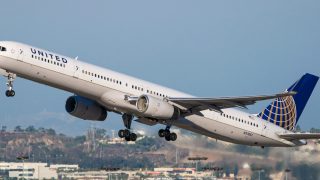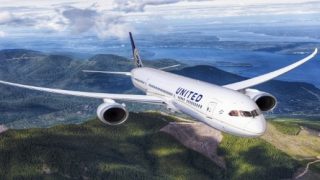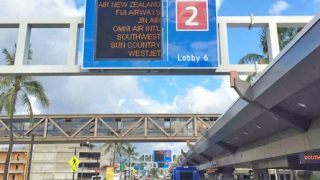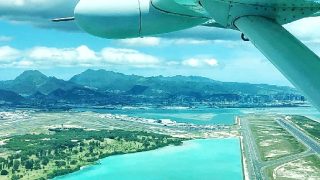Yesterday’s engine failure onboard United Airlines’ Denver to Honolulu flight 328 caused us to think about Hawaii airline safety and prior events. After all, once you get out over the Pacific (which this plane was not yet), you can be 2 1/2 hours or more from the nearest point of landing. The situation is serious enough that United has just grounded that fleet of 777-200 aircraft.
In the latest (February 21, 2021) headline event, the 26-year old Boeing 777-200’s PW4077 engine explosion was apparently what is considered the most dangerous “uncontained failure” type. That according to a former NTSB member, who reported that parts of the engine were not contained and exited the motor, thus potentially endangering the wing and fuselage. The last strangely similar incident on a Hawaii flight happened just three years ago.
Yesterday’s problem manifested soon after takeoff, and the plane made an emergency landing less than 1/2 hour after departure from Denver. Videos like the Twitter one below showed flames emanating from the engine’s mid and rear sections.
Passengers were told to brace, and thankfully, the plane landed uneventfully. The incident occurred at about 23k feet on the climb out for what would otherwise have been an uneventful 7-hour flight to Honolulu. That was when the pilot announced, “We experienced engine failure. We need to turn… Mayday. Mayday, United 328 heavy just experienced an engine failure, we need to turn immediately.” Air traffic controllers aided the failed plane, both clearing an immediate descent and offering the airport, saying, “You can have any runway you like.”
Flight 328 @united engine caught fire. my parents are on this flight 🙃🙃 everyone’s okay though! pic.twitter.com/cBt82nIkqb
— michaela🦋 (@michaelagiulia) February 20, 2021
Today, United Airlines said it will temporarily ground its 24-plane fleet of Boeing 777-200 aircraft that are powered by PW4000 engines. Generally, Boeing 777 is considered one of the world’s safest aircraft. Less than 1/2% of the nearly 1,500 produced have been involved in accidents or other problems that were beyond repair.
Prior earily similar UAL Flight 1175 Hawaii bound plane incident.
In February 2018, another UAL 777 had an issue that appeared to be very much like yesterday’s problem. The plane in the 2018 accident also went into the service in 1994 and was of the same aircraft and engine type. In that situation, the plane was indeed dangerously mid-Pacific when the engine failed.
UAL Flight 1175, with 373 passengers and crew on-board, was inbound to Honolulu from San Francisco, less than an hour away from landing. The plane shook violently, and loose metal and bolts flapped against the plane as oxygen masks dropped from the ceiling.
Later, the NTSB said the failure was caused by “a full-length fan blade fracture.” Further, NTSD indicated that the manufacturer had not noticed blade fractures during their prior routine maintenance inspection.
UAL 811 mid-air incident.
United 811 suffered a cargo door failure in February 1989 en route from Honolulu to Auckland. The 747-100 experienced explosive decompression that ejected rows of seats that caused the deaths of 9 passengers. It landed safely again in Honolulu.
Aloha Airlines flight 243.
Perhaps the most well-known Hawaii aviation incent occurred in 1988. As you recall, flight 243 suffered a catastrophic fatigue failure. En route from Hilo to Honolulu, the Boeing 737-200 suffered extensive damage when an explosive decompression happened mid-flight. It nonetheless landed safely on Maui. There was one fatality, a flight attendant who was ejected, while an additional 65 passengers and crew were injured. It was an important event and had a significant impact on aviation safety procedures that followed.
Hawaiian Airlines 2000 runway incident.
Hawaiian is considered among the safest airlines and has never experienced a fatal accident or a hull loss. Nonetheless, in 2000, a Hawaiian legacy DC-10 aircraft en route from Honolulu to Papeete overran the runway at Faa’a on landing. A subsequent investigation indicated it was caused by an incorrect aircraft landing configuration while landing in a thunderstorm. There were no fatalities.
Canadian Pacific fatal crash.
A Canadian Pacific turbo-prop crashed and burned during an emergency landing at Honolulu in 1962. 27 were killed while 13 others survived. The plane, bound for Nadi and Sydney, attempted the fatal return to HNL just 20 minutes into the flight. The aircraft crashed into equipment at the airport which resulted in an explosion.
Pan Am Hawaii-bound flight accidents.
PAA flight 7 crashed into the Pacific en route from San Francisco to Honolulu in 1957. All 44 passengers and crew died aboard the luxury Boeing Stratocruiser, which was on an around-the-world voyage. The cause of the crash was never proven, but theories included fire, equipment failure, and sabotage.
PAA flight 6 was also on an around-the-world mission when it ditched in the Pacific in October 1956, after two of four engines failed on its planned flight to San Francisco. The plane sank but the 31 on-board were rescued. It was the basis of a later film.







Aloha! Thank you for all you do! I have been following your advice for years and I have benefited greatly. I have a tough one for you. Like everyone else I am anxious to visit family this summer. I am trying to avoid having to stop at a layover hotel for safety reasons. I am trying to find lie flats OGG to the west coast with final destination of GEG. So far I have found Delta OGG to SLC red eye. Not exactly west coast but worth it to me for the lie flat red eye. I can do open jaw and return on a different carrier like Hawaiian’s 330. Not concerned with price as much as itinerary. Looks like a layover In HNL might be necessary. But I would appreciate your thoughts. Mahalo Nui Loa🌺
Hi Carolann.
Thank you. You are right that there are few options for lie flat going that way. The Delta one you mentioned is good. On the return, there is a routing on United via Denver that is lie-flat to Maui. We could have missed something but that’s really all that we found. Good luck on that.
Aloha.
Who doesn’t at least contemplate having to ditch while in-flight mid-Pacific? Most everyone relies on stats and not worrying about it. Not a bad strategy given the stats. I do the same once I’m in the air. But before I’m in the air I do what I reasonably can to tilt the stats in my favor for both water and land incidents ever since I saw a piece of a wing let go while flying over the Rockies.
First, pick seats toward the rear for a modestly better chance of survival as you will be farther from engine debris, even better in an aisle seat, not so much for your window seat neighbor. Seat and aisle position can mean everything when survival is a matter of seconds. Also the fuel tanks are under the wings.
Second, if possible fly during the day so the pilot can execute a textbook water landing along a cresting wave swell. Impossible to do at night and most likely catastrophic.
Third, wear non-flammable clothing unless you want to become a candle. Jeans are good, especially Wrangler FR as they have Nomex fire resistant thread and zippers otherwise ouch!
Have tough gloves in your bag if you’re coming from some place cold and survival may mean tearing red-hot metal out of the way.
Fourth, consider a smoke hood in your carry-on. The Flight Crew have them so shouldn’t you?
Fifth, if you ditch in the sea swim toward the wind so the wind will blow fuel/flames in the opposite direction.
Sixth, board the plane and know that in the extremely unlikely event that something should occur you will have given yourself the best chance you could going forward.
Thanks
Hi Scott.
Thanks for all that great aviation information.
Aloha.
I worry that you are scaring flyers unnecessarily. A Boeing 777 is able to fly the journey from the Mainland to the Islands on one engine without issue, it will just take longer. THe major worry with engine failures is parts from the engine entering the cabin and injuring pax or compromising the equipment. In this instance the damage to the fuselage was slight to minimal. The Pratt and Whitney engines 4077 series are only used in the USA on early Boeing 777’s by United and overseas by JAL and Korean Airlines. Boeing have full supported the grounding of all the affected aircraft for ultrasonic tests to see if any other engines have internal cracks in the hollow titanium fane blades.. As we know many of these older 777’s are already in storage due to the Covid travel restrictions. Nervous flyers to Hawaii have no reason for concern. P&W have long since left the 777 model with GE building the more powerful and more fuel efficient engines on later models. Airbus had a similar issue with Rolls Royce Engines on the Airbus A380 although then it was a new model with current product. This incident did not endanger any souls and thankfully caused no injuries on the ground.
I used to work for AA from 1991 to 2003 as a facilities mechanic, and when I was stationed at SFO, one morning I was ending my shift at 7 and talking to a ticket agent who just finished the boarding process. The plane had taken off some time earlier, and was climbing. She was completing the paperwork when she got a sudden call to meet the plane again due to an emergency. She couldn’t do it just yet so I offered to meet it for her. I ran down and I extended the jet bridge to the plane; she came running down, the passengers got off and were thanking the pilots on the safe landing of the Super 80 (longer DC 9). Everyone said there was a loud explosion to the starboard engine; they’re on the back. I went outside to see if there was any visible damage, but nothing was missing. This emergency was handled quickly and safely by the pilots and control tower.
I remember when the 1988 incident occurred. I was shopping at Kaahumanu mall, and it was a beautiful day.
All of a sudden the air raid sirens went off and every emergency vehicle around was on the road. I looked up and saw the plane landing with all kinds of debris hanging out of it, including passengers that we strapped in their seatbelts.
Everyone at the (outdoor) mall was wondering what happened. Seemed like the end of times.
We found out shortly that the only missing person was a flight attendant that was checking on passengers and out of her seatbelt in her seat. She was a beautiful young lady, who was concerned about others.
The Aloha Airlines aircraft stayed on the side of the runway for months. Everytime I had to fly to Oahu for business, we’d all see the decimated plane right there as we took off or landed. It was sad and terrifying to see.
We all hoped and prayed that somehow they’d find the flight attendant and give her family some closure, but it never happened.
I’ll never forget that day.
This latest incident is a reminder that no day is promised, and Aloha is and Ohana are all that matters in this life.
Blessings to all and again, mahalo to Beat of Hawaii for the stellar reporting.
Hi Pam.
Thanks for your first-hand report from that terrible day.
Aloha.
do these aircraft not have fire extinguishers on the engines to at least put the fire out.
Great job by the cabin crew and the pilots!!!! They are hero’s!
Perhaps there was a run in with a flock of birds on takeoff?
In 1989, United Flight 811, left HNL for New Zealand when it lost a large part of it’s fuselage around a Baggage compartment. 9 people were sucked out to their assumed deaths. I was surprised this incident was not mentioned. Maybe it’s just me, but over the years, just my observation, UAL doesn’t seem to be the best at their maintenance. I could be wrong of course. JMHO
Hi Cin.
Thanks. We added the 811 details to the post.
Aloha.
Aloha,
Please correct the spelling of Faa’a.
Mahalo,
Charlotte
PS- I am so grateful that UA328, along with its passengers and crew, returned safely to DEN yesterday. It was a bit disconcerting while it was happening and the debris was dropping so close to home. A huge thank you to the crew!
Hi Charlotte.
Thanks for that correction on the name of an airport we both know very well.
Aloha.
Mahalo for the interesting history lesson.
Aloha Guys.
Hi Roy.
Thanks. We either didn’t know of or had forgotten some of these ourselves. And the comments helped with the ones we missed.
Aloha.
My family was on an AA 767 leaving HNL that was turned around after about an hours flying time while over the Pacific. All we were advised is that an indicator light came on and they didn’t want to continue. When we arrived back at HNL, we were met by several fire trucks and towed. I admit, it was more than a little frightening. I can’t imagine how terrified these passengers were. We were well taken care of by AA and put up at the Hilton Hawaiian Village and given a food allowance until they could get everyone booked on another flight. In our case, that was 3 days.
Fortunately, aircraft can operate on one engine. That said, I wouldn’t want to be over the Pacific when that happened! The crew is to be complimented!
Do not forget that there was another uncontained engine in Maastricht on a 747 yesterday also. Both the 747 and the 777 were using Pratt & Whitney engines. Not saying the issues are the same or related, but to have TWO similar incidents happen on the same day…what are the chances?
As long as it doesn’t happen on the same two-engined airplane, which ETOPS is intended to render nearly statistically impossible, the passengers and cargo will be fine on both ships.
ETOPS = Engines Turn Or Passengers Swim
Or
Engines Turn Or Plane Sinks
Barring the funny remarks, if the plane is ETOPS certified it shouldn’t matter if the engine failure happened over land or ocean…..it should be able to make it the 2 1/2 hours on just 1 engine (would probably take longer though with just the 1 engine) either back to the mainland or on to Hawaii.
The woman that was sitting right in front of the wing said that she really didn’t notice anything until she looked out and saw the engine wiggling around and the flames at the back of the engine. Other than that, people were calmly reading and did not seem concerned as well they should be as that aircraft can fly quite well on one engine. They were not going to make it to Hawaii that way so basically no harm, except to maybe some overreacting people’s underwear, no foul and they were put on other planes to get to Honolulu.
What do you expect from boeing airplanes anyway other than “boeing down”???
Really. Come on
The ongoing, cultural, racial discrimination, anti American sentiments, logistical, financial, governmental issues with Hawaii are proving to be irreconcilable and unforgiving.
Without commenting on whether you are right or wrong, What does your statement have to do with this particular incident?
This incident just serves as another reminder that Hawaii comes with many challenges whether you are visiting or living there.
You are completely reliant on airplanes for travel,even interisland. And then having to deal with pandemic and other issues that might arise.
Mat
This person finds it entertaining to make negative comments about Hawaii in general.
Uncertain why, been posting negativity for months from what ive noticed.
It looks like water was being sprayed on the engine. Is that an automatic safety procedure that somehow happens? Just wondering how that works. Thanks for any information you could offer.
Hi Rita.
Maybe someone more knowledgeable can lend a hand. There are a lot of aviation types around.
Aloha.
That is not water spraying into the engine. Each engine has 2 internal chemical fire bottles. What you’re seeing is a reflection of light on the camera lens.
I believe the last incident involving a PA stratocruiser is incorrect. There was a water landing in the Pacific but it took place in the early 50’s. That flight was bound for SF from HNL. The pilots realized they would have to ditch but were able to wait until dawn so rescuers would have an easier time rescuing the crew and passengers. They were in constant contact with a US Naval ship. (These ships were stationed at the halfway point during those years for radio purposes.) They finally landed in the water…all were rescued. Excellent outcome in what could have been a tragedy. Beyond the halfway mark, they would call it “the point of no return”.
Hi Maleko.
We believe the information in the post is correct. https://en.m.wikipedia.org/wiki/Pan_Am_Flight_7.
Aloha.
No one survived the crash in the provided link. I believe it is much more likely the incident described was https://en.m.wikipedia.org/wiki/Pan_Am_Flight_6.
This was the other Pan American incident I was referring to. Your description was correct.
http://airlinesafety.com/editorials/DitchingOfPanAmFlight6.html
Hi Maleko.
Got it and added the other incident. Thanks.
Aloha.